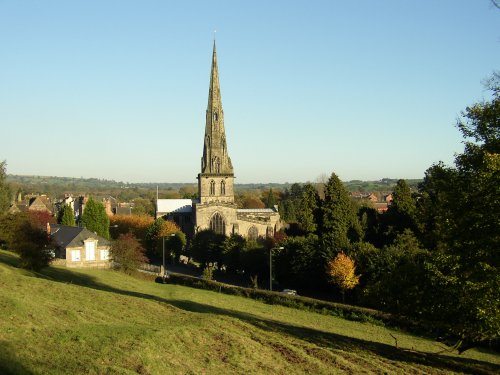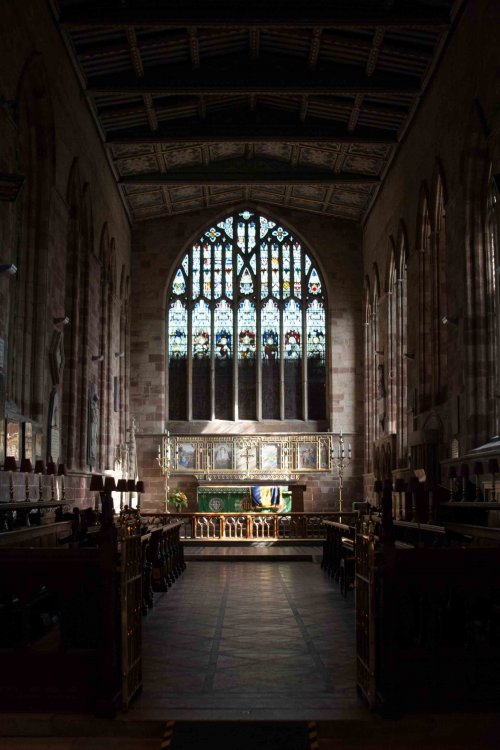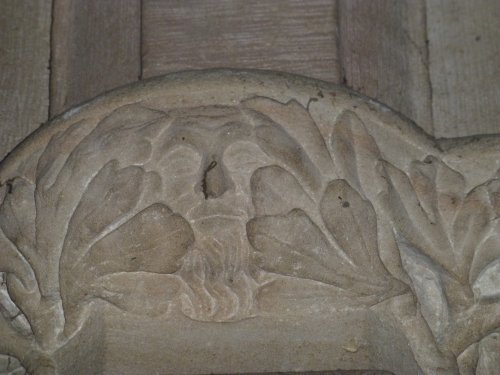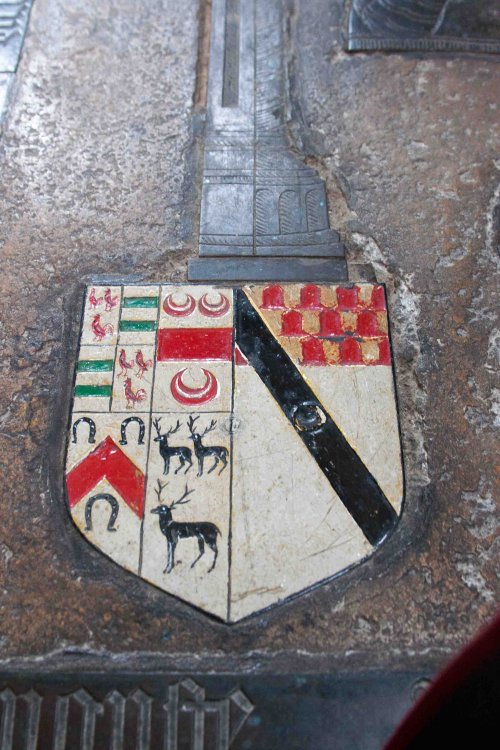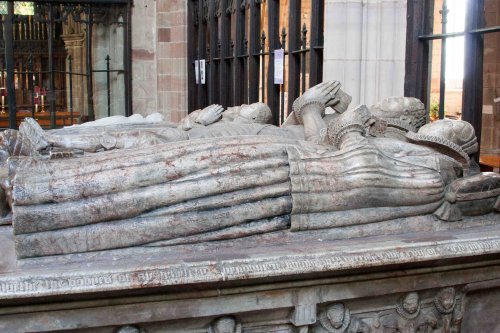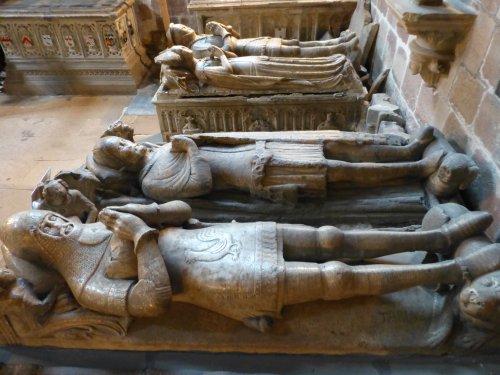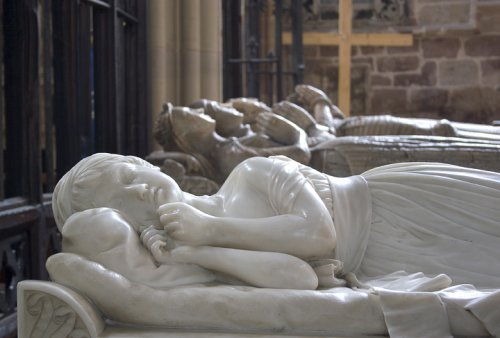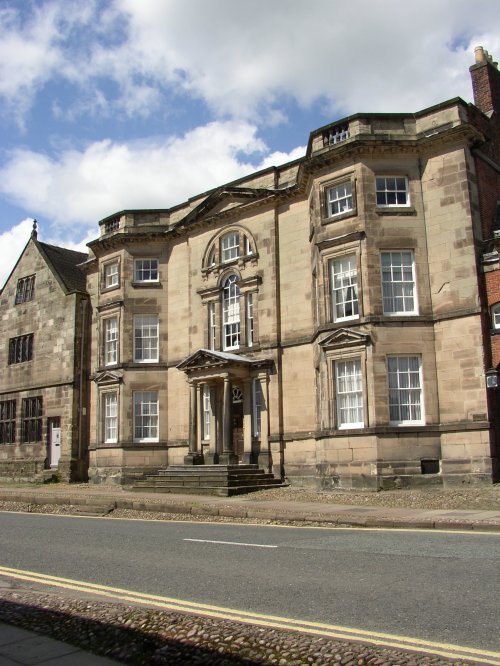A north aisle of St. Oswald's Church was never built. This may possibly be the result of the impact that the Black Death had on the area.
Described by the writer George Eliot as “the finest mere parish church in the Kingdom”, St Oswald’s Church has a slender spire 212 feet high and was once a candidate to be the cathedral for the Derby Diocese. A church at Ashbourne is mentioned in the Domesday Book of 1086 though this was almost certainly a wooden construction. Evidence of a Norman Crypt was found during renovation works in the early 20th Century but the existing church dates from the early 1200s and the 1241 dedicated plaque is believed to be the oldest in Britain. The oldest parts of the present building are the chancel (eastern end of the church containing the altar) and the transepts (the arms of the church), which were built in the first half of the 13th Century. The main part of the nave (the body of the church where the congregation sits) was added in the mid-thirteen century and was widened in the late 13th Century by the addition of south aisle when a tower was also added; a north aisle was never built, possibly because of the impact of the Black Death. The last major construction was the spire, which was built in the early in the 14th Century.
Local legend says that a spring under the tower, found during strengthening work in the early 1900s, was the site of pagan worship. The presence of this spring may explain why some major structural repair was required to support the weight of the tower and spire.
There are a number of unexplained features in the Church. Here are 3 – perhaps you can help to explain why:
1. The Church chancel and nave were built at an angle. You can see this if you stand at the west door to the church and look along its full length. Did the stone masons make a mistake, was there a problem with the ground, or does it reflect the angle of Christ’s body on the cross?
2. On the floor of the Chancel, one of the Victorian fleur de lis tiles is mounted the wrong way round. Can you find it and was it a mistake by the tiler or is it a way to show that only God can make something to be perfect?
3. The 18th Century gates to the Churchyard have carved skulls and flames on the top of the pillars. Do these remind us that we are mortal and warn of hell fire if we do not behave in a Christian manner, or do they have an earlier pagan significance - such as the lights put inside pumkin heads at Halloween? When the Victorian art critic John Ruskin visited the Church in 1875, he was not impressed with these skulls and suggested that the Vicar should "employ honest labourers to break up the skulls for use on the local roads".
St Oswald’s Church has some splendid stained glass ranging from medieval to early 20th Century. Medieval glass, dating from the consecration of the Church in the 1240s, can be seen on the west wall of the northern transept, where a series of 5 roundels depict scenes from the childhood of Christ.
The east window, built in early perpendicular style, contains a marriage of 14th and 19th Century glass. The heraldic arms of John of Gaunt and 17 of his local knights date from the replacement of the window in 1395. Fortunately, the Victorian glass designer, Kemp, realised the importance of the medieval glass and tastefully worked them into his new design.
The first window in the south aisle, the Turnbull window by Christopher Whall, is one of the finest Arts and Crafts windows in the Country and commemorates Monica and Dorothea Turnbull, who died in a fire at the nearby Sandybrook Hall in 1901.
Not all the windows were held in high esteem though. During a visit to the Church, the Victorian Art Critic John Ruskin said that the figures in the double lancet window in the south wall of the chancel “would disgrace a child’s penny book of Jack the Giant killer”.
Facing the nave, on the pillar in the southwest corner of the crossing is a carving of a green man, a face surrounded by leaves. Although at first sight, such an image would appear to be pagan - perhaps a fertility figure or a nature spirit - such carvings are quite common in medieval churches and are believed to be a symbol of rebirth. The Green Man is also a popular name for English public houses and there is the Green Man Inn in Ashbourne in the Town centre, although the inn sign depicts a hunter rather than a man made from leaves.
The spire and the weathervane have been subject to repeated repairs. The cock at the top is a reference to the arms of the Cockayne family. It also provided the name Charlie Chuck-chuck, the nom-de- plume of George Shaw, a local historian, when writing articles for children.
TIME LINE OE THE SPIRE
1330 The Upper Stage of Tower and Spire is erected on the instruction of Antony Bek, Dean of Lincoln.
1698 The Spire is much damaged by a ’Gale of Wind'.
1783 The upper portion of the Spire is taken down and rebuilt.
1873 The upper portion of the Spire is taken downagain and rebuilt. The Rev. E. M. Moore, Vicar of Ashbourne, is illustrated placing the weather-cock in its place.
1891 Restoration of Tower and Spire and re-hanging of the bells is carried out.
1912-3 Restoration and Strengthening of the Tower is undertaken.
1931-2 The Tower is strengthened by filling in the newel staircase at S. E. corner and tying together the walls with a reinforced concrete floor above the Belfry. The bells were re-hung at a lower level and are now rung from the floor of the crossing.
The chapel in the north transept contains a collection of monuments. Inside the chapel itself, the oldest effigies are those of John and Sir Edmund Cockayne, Kt. who died in 1372 and 1403 respectively. At the entrance to the chapel is a wall monument to Thomas Cockayne, died 1592, and his wife, Dorothy. Thomas was one of the founders of Queen Elizabeth’s Grammar School, which was given its charter in 1585 and his coat of arms is still used as the school badge. In the left hand corner of the chapel is the tomb of another Thomas Cockayne, died 1537, who was dubbed 'the magnificent' by King Henry VIII. Thomas was a keen huntsman and the rhyming epitaph on his grave is believed to be the oldest in England.
There are two tombs for members of the Bradbourne family which were originally in a chapel in the south transept and moved around 1840. The earliest one is for Sir John Bradbourne, d.1483, and his wife, Anne Vernon, d.c.1500, who had founded a chantry chapel in the South Transept about 1483. John fought in Spain in the army of Ferdinand and Isabella of 'Spain'. He was awarded the badge of Granada which can be seen on the dagger of the other Bradbourne effigy, his great grandson. Anne wears a necklace of cockle shells, suggesting that during a visit to Spain she made the pilgrimage to Santiago de Campostella. She was the daughter of Sir Richard Vernon of Haddon Hall and Tong. Her sister married Sir John Cokayne, d.1505, and their tomb lies opposite.
The biggest tomb in the chapel is for Sir Humphrey Bradbourne, d. 1581 and his wife, Elizabeth Turville. The tomb is one carved by the firm of Richard and Gabriel Royley of Burton-on-Trent, who were 'inexpensive and popular'. Around the tomb are ‘weepers’ for their six sons, six daughters and three chrisom children who died in infancy. The children bear shields showing their father's arms, on the left for the boys and on the right for the girls.
Sir William Boothby of Broadlow Ash purchased Ashbourne Hall and much of the estate in 1671 and his family lived there until the mid-19th century. The Boothby chapel in St Oswald's contains many monuments to the family and includes one for Miss Hill Boothby, the friend and correspondent of Dr Samuel Johnson.
The most renowned of the Boothby monuments is that of a five year old girl, Penelope Boothby. Penelope, the only daughter of Sir Brooke and Lady Boothby, was born in 1785 and Sir Joshua Reynold's ‘Portrait of Penelope’, often called "The Mob Cap", is one of the most famous of English child portraits. She died shortly before her 6th birthday in 1791. The tomb, by Thomas Banks, depicts a sleeping child in a long frock and is said to have moved Queen Charlotte to tears when she saw he work at the Royal Academy exhibition before it was moved to Ashbourne.
It is inscribed with an epitaph;
"She was in form and intellect most exquisite. The unfortunate Parents ventured their all on this frail Bark. And the wreck was total."
Her father, Brooke Boothby, was extravagant, emotional and self-indulgence and his daughter's death permanently affected him and he subsequently published a book of poetry, Sorrows Sacred to the Memory of Penelope. Boothby's life went into decline after his daughter's death and his wife Susanna returned to her parent's home in Hampshire settling in Dover. Her death was recorded under her maiden name of Bristoe.
Boothby never recovered from the emotional loss and financially crippled by his excesses he left Ashbourne, never to return; after roaming the continent he finally settled in diminished circumstances in Boulogne in 1815 and died there in 1824.
The Cockayne family were effectively 'Lords of the Manor' from 1340's to 1671. Their tombs in St Oswald's church form one of the finest family collections in the County and Country.
The Boothby family bought Ashbourne Hall in 1671. They landscaped the Park substantially, including diverting the Henmore and closing the Wirksworth road. The tomb of Penelope Boothby in St Oswald's church is renown.
Brian Hodgson, resident of the Grey House, was an innkeeper and business man, with fashionable inns at Stamford and Buxton and considerable investments in copper mining.
On the wall of the north aisle of St Oswald's Church, near the transept, is a small memorial to the Rev Dean Langton who died on 28 July 1761.
First brought Methodism to Ashbourne in 1754
Ashbourne was one of the towns in Britain which had French PoWs billeted on them. French officers and their servants were housed around Ashbourne. One, John Peterson, stayed and is buried in St Oswald's church.
The Barmote Court was an early form of industrial court to regulate the local lead trade. One was held in St Oswald's church in 1287.



